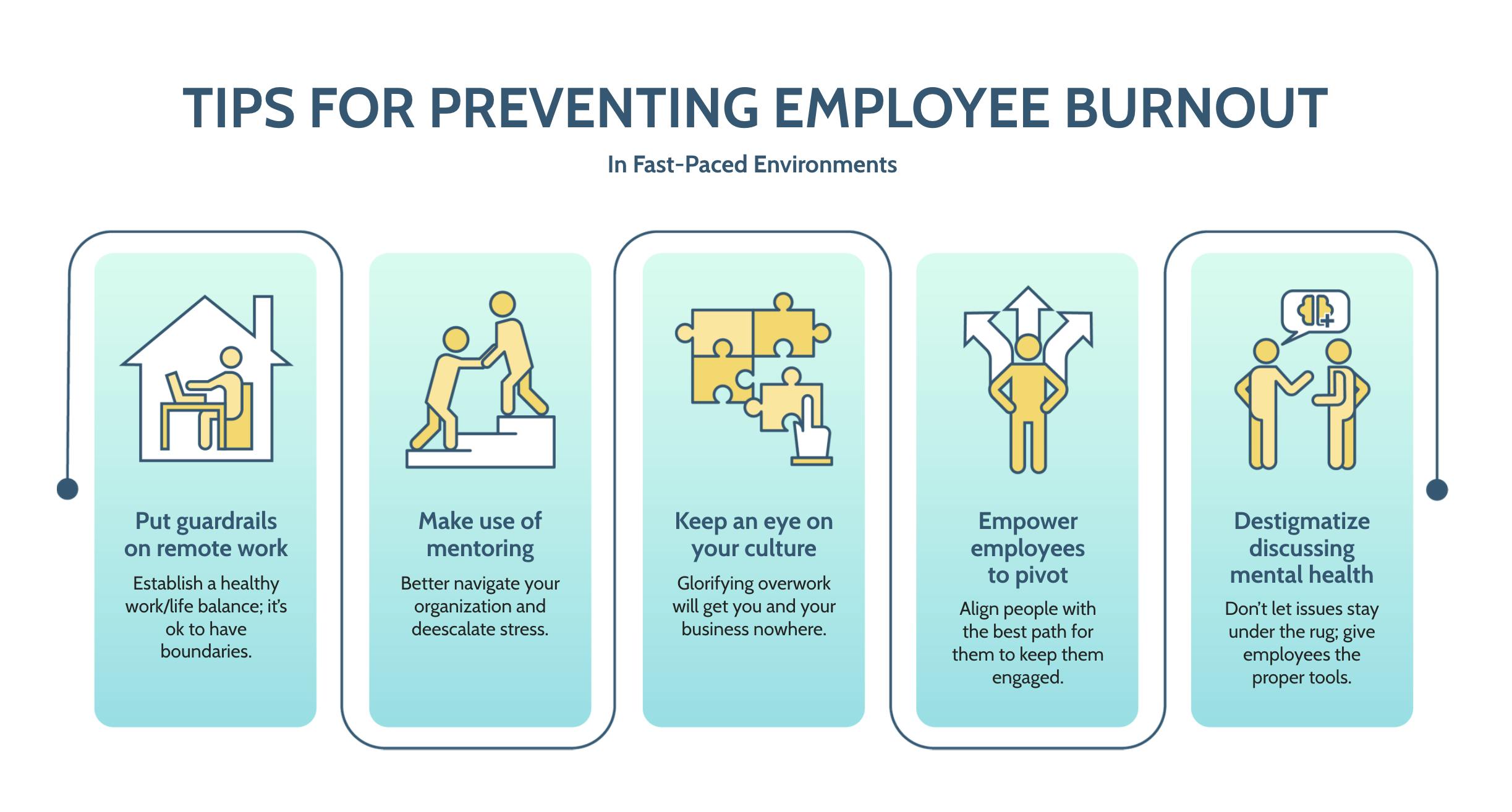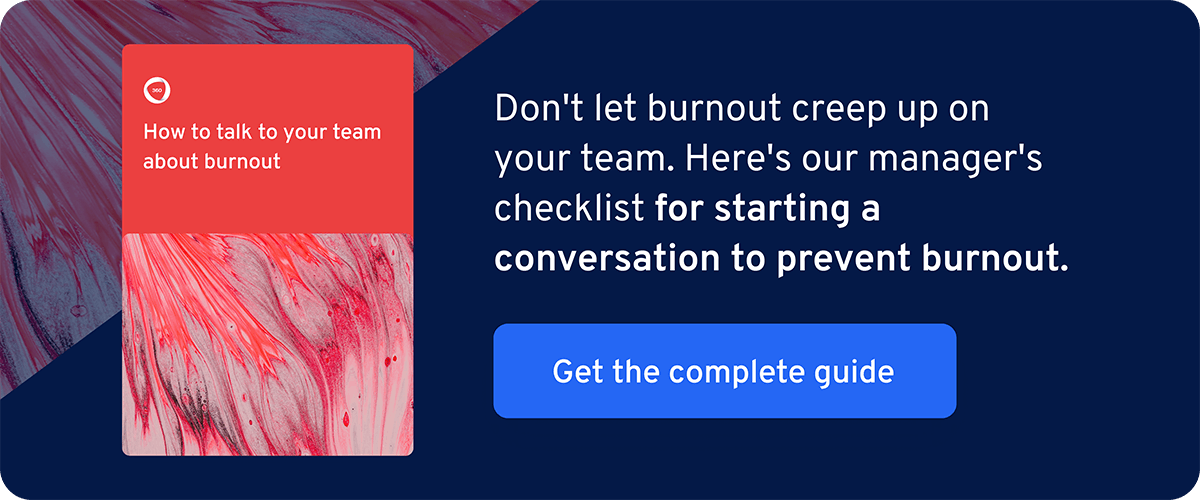
How Leading Companies Are Preventing Employee Burnout (While Still Driving Growth)
According to data collected by global staffing firm Robert Half, 44% of employees say they are more burned out on the job today compared to a year ago.
Pandemic-related stress, long hours and sparse vacations, off-kilter work-life balance...many people are getting to the end of their rope when it comes to work-related stress. Employee burnout is a growing concern, especially for employers looking to transition to a hybrid work model and retain talent during “The Great Resignation.”
But what can organizations actually do to prevent employee burnout? We asked some of our peers to weigh in. Below, we’ve collected their top advice for mitigating workplace stress, before it gets out of hand.
But first, if you’re worried you or someone on your team might be burning the candle at both ends, take our burnout quiz to see how your burnout risk score compares to thousands of other employees:
Now, on to our crowdsourced tips for preventing employee burnout:
1. Put guardrails on remote work
“When the transition to work is no longer clearly defined, and your “getting ready” process means simply moving from the bedroom to the coffee table, the lack of boundaries between “work” and “rest” can weigh on people—leading to more stress or longer hours.” - Goco.io
For many, remote working is largely beneficial: more time in the mornings, increased flexibility, the chance to work at a company you’re not in commuting distance to…but a poor work from home set-up can also blur the lines between work-life and personal life in ways that aren’t healthy or productive.
At 360Learning, we’re big proponents of a remote-first model—but we also fully acknowledge that, if the proper processes aren’t in place, it can be counterproductive. One common issue is employees feeling isolated. Jeniffer Strub, Director of Human Resources at Vyond, explains,
"My team surveyed 1,000 U.S. employees about the state of remote work and found 40% are frustrated by feelings of disconnect from colleagues. It’s just one example of how workers are struggling under the surface in a way that isn’t easily recognized in our new remote environment."
Another danger sign? Zoom fatigue. Virtual meetings, especially back to back, can be draining for remote workers. And while a commute can be bothersome, it does provide a buffer between one’s home and work life that has vanished in a WFH setting. Couple all that with the pressure to be available 24/7, and it’s not surprising some employees are starting to feel the burn and even sleeping at work.
Solutions to remote-induced burnout include putting up boundaries around people’s downtime. Video conferencing software company Livestorm, for instance, started ‘Focus Fridays’, to allow Stormies to shut off non-urgent notifications, avoid meetings, and make time for deep work.
Other tips for preventing burnout in a remote setting include:
- Regular check-ins (one-to-one meetings, anonymous surveys…)
- Connecting with colleagues (online coffee breaks, buddying up, virtual team building…)
- Keeping a watch on communication styles (limiting the number and duration of meetings, expectations around when emails should answered…)
- Training workshops on work/life balance
- Providing adequate budget for remote office set up (ergonomic keyboard, chair/desk…)
And this really is the bare minimum, as Ryan Carruthers of Together Platform explains: “As things settle into whatever the new normal will look like, we need to find better ways to establish work/life balance. The goal shouldn't be to avoid burnout, but find ways to thrive at work.”
Related: Now Is Our Only Chance to Fix Remote Work— Here's How We're Doing It
The goal shouldn't be to avoid burnout, but find ways to thrive at work.
2. Make use of mentoring
“The ability to discuss the problems with one another, support and advice, the mentorship connection, enhanced confidence and encouraging healthy choices are some of the ways that mentoring in the workplace can help employees deal with stress and reduce the chance of burnout.” - Together Platform
The solution to burnout isn’t to ask already stressed employees to ‘fix themselves’. Instead, it’s up to employers to help build strategies at the organizational and team level, while not ignoring factors at the individual level, either.
One powerful option is to put in place an employee mentoring system. As Together Platform explains, mentoring has been shown to reduce stress and improve well-being in both the mentor and mentee. The former often feels more purposeful, and might have some of their opinions reaffirmed by their colleague. The latter benefits from the advice of someone who knows the organization’s ins and outs, and can help resolve or avoid interpersonal problems.
Mentoring can reduce stress for all involved through:
- Discussion
- Advising
- Skill development
- Enhanced confidence
- Support of healthy choices
Such programs are easy to set up, and they help tackle the kinds of transparency, overwork, and fairness issues that often fuel burnout.
Related: The What, Why, and How of Mentorship Programs at Work
The solution to burnout isn’t to ask already stressed employees to ‘fix themselves’.
3. Keep an eye on your culture
“We know that work is only one part of life and the amount of space that part takes up is unique to us all. That’s why we encourage people to hit pause, take breaks, and unplug whenever they feel the need to.” - Andy Johnson, iorad
Do you get emails from your boss at 11pm? Do they expect you to respond to a Slack message in the minute following? Do they often slip into the conversation that they can’t remember the last time they took a vacation?
There’s no doubt that in fast-growing companies, it’s common to glorify a “hustle” or “grind” mentality. But overworking at the expense of your mental or physical well-being will certainly backfire, and companies that create a culture around 24/7 work will see their employees drop off.
But it’s not just imbalanced workloads that lead to burnout. Company cultures that aren’t transparent or that are deemed unfair are also leading causes of employee burnout. That’s why it’s important to:
- Communicate clearly from the top-down (no secrets or backdoor meetings)
- Have a clear, fair system around compensation, promotions, and rewards
- Cultivate an environment of psychological safety
This type of approach might be particularly needed on certain teams more than others. Craig Moore, Head of Sales at Vyond, explains how Sales Teams, because of the performance-driven nature of their work, are particularly vulnerable to burnout, and how sales leaders can step in to build a better culture:
“As the leader, you have the responsibility of setting the tone for your sales team. I believe strongly that you can create a culture that is performance-driven, empathetic, and fun. All of those elements can coexist and it’s so important to state that this is something you believe in and then show up in that way every single day.”
Modeling healthy behavior from the top down and being intentional about the kind of company culture you’re building—implicitly or explicitly—is important to ensure you don’t create a breeding ground for overwork and stress.
Related: The Dual Approach You Need to Fight Employee Burnout
We know that work is only one part of life and the amount of space that part takes up is unique to us all.
4. Empower employees to pivot
“Healthy communication between employees and managers plays a vital role in mitigating the effects of employee burnout. No workplace is better than one where an employee can trust their employer enough to have honest conversations about what is stressing him/her out and suggest possible solutions.” - Manoj Parikatil, Goodera
While there are undoubtedly organizational and personal elements that contribute to burnout, it’s worth considering whether a more fundamental misalignment might be the root cause. What if an employee just isn’t happy with their role anymore?
Aili Olichney, Creative Community Builder at Genially, elaborates: "Someone once told me that burnout isn't caused by working too hard; it's a result of continuing down a path that is no longer yours.” But, at least at Genially, just because you realize you might not be 100% fulfilled in your current role, doesn’t mean you have to say goodbye:
“While I definitely believe that working long hours can cause burnout, there's a key idea here that Genially has zeroed in on. Genially prioritizes finding the right fit for its team and has even allowed team members to change their focus and even area in order to find a role that best fits their abilities and personal growth goals. Finding alignment between a person's vision for themselves and the company's vision of what they can do best is essential to keeping burnout to a minimum, and it's one of the reasons our team is flourishing."
There’s no doubt that professional development is foundational to employee satisfaction; in our recent survey of 600 American learners, our respondents found it very important (86 on a scale of 1 to 100) that their employer encourage their professional development.
What if companies could proactively prevent burnout by ensuring—during performance reviews, one-to-one meetings, feedback surveys—that their employees still felt purposeful in their current position?
Likewise, if they were able to continuously provide clear opportunities for professional development, could this help stave off major disengagement? It’s certainly a tactic worth investing in, if not only to prevent burnout, but to keep employees motivated on a larger scale.
Related: Why Most Talent Development Programs Suck (And Why Yours Doesn’t Have To)
Finding alignment between a person's vision for themselves and the company's vision of what they can do best is essential to keeping burnout to a minimum.
5. Destigmatize discussing mental health
“So often when organizations focus on burnout, they only look at workload and forget to take mental health into consideration. Whether it's integrating mental health into your organization's physical health plans, administering frequent pulse checks, or encouraging positive communication, prioritizing mental health goes a long way in reducing or halting burnout.” - Aimie Ye, GoCo.io
You don’t want to wait until burnout is underway before doing something about it. But if your company is one in which bringing up the topic of mental health is touchy or even taboo, chances are even higher that issues will stay under the rug.
Thankfully, more and more organizations are realizing the benefits of being open about discussing mental health. To name just one example, Livestorm has partnered with Moka.care to offer Stormies the possibility to discuss with mental health specialists if needed.
Virtual volunteering platform Goodera has a similar initiative, as their HR Director Manoj Parikatil explains: “We use RoundGlass Reach to curate wellbeing programs for our employees. The app facilitates meditation sessions, free therapy sessions, mindfulness webinars, and a repository of wellness content that are accessible to all our employees.” Other companies like Cheerz opted for a comprehensive and holistic approach provided by teale, which offers employees both support from therapists and digital therapy tools.
In addition to flexible work schedules and wellness initiatives like Yoga Friday, teams at HR platform GoCo also encourage HR managers to openly share the health insurance information available to employees, which might include resources like an Employee Assistance Program (EAP). Even a subsidized gym membership can help boost physical activity in your workforce, another ingredient in helping reduce stress and burnout.
If you’re simply looking for an easy way to communicate about the topic, Vyond offers ready-made video templates that can be used to raise awareness around mental health and direct people to the proper resources.
Related: 5 Ways to Tackle Employee Burnout
So often when organizations focus on burnout, they only look at workload and forget to take mental health into consideration.
Social psychologist Christina Maslach, of the University of California, Berkeley, emphasizes the environmental causes of burnout: “We should be trying to identify and analyze the critical components of ‘bad’ situations in which many good people function. Imagine investigating the personality of cucumbers to discover why they had turned into sour pickles without analyzing the vinegar barrels in which they had been submerged.”
We all have a role to play in ensuring that our work environment doesn’t turn toxic. Those in leadership roles can model healthy behavior, sponsor wellness and mental health programs, and guide their company culture in the right direction; HR and People teams are well-placed to flesh out wellness initiatives and balanced remote-work policies; L&D teams could investigate mentoring programs and productive professional development training.
Individual contributors can speak up when they start to feel things getting out of hand, and generally support any initiatives at their disposal, and managers can foster community building and keep in touch with their direct reports during regular check-ins.
This past year has certainly presented challenges for any organization. Hopefully, we’ve learned some strategies and coping mechanisms for managing stress, continuing to feel purposeful on the job, and generally prevent a wave of burnout.
If you want to explore the topic further, and in addition to the resources shared in this article, feel free to take a look at our manager’s checklist for starting a conversation with your team about burnout.




